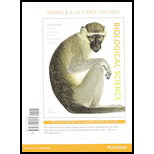
Concept explainers
Introduction:
All organisms behave and respond in different ways to various stimuli. This depicts their adaptive level and the success of their evolution. The behavior or cause of any organisms or an event can be explained in two ways on the basis of the mechanism (proximate) and on the basis of evolution (ultimate).
Answer to Problem 1TYK
Correct answer:
The proximate explanations of behavior focus on genetic, neurological, and hormonal mechanisms of behavior.
Explanation of Solution
Justification for the correct answer:
Option (c) is given that the proximate theory relies on the genetic, neurological, and hormonal factors for the explanation of any behavior. This theory depends on the mechanisms that take place inside the body of the organism under study. Hence, option (c) is correct.
Justification for the incorrect answer:
Option (a) is given that displays and other types of behavior change or evolve over time. The ultimate theory depends on the evolutionary process for explaining the behavior and displays of an organism. The behavioral patterns are justified on the basis of the evolution of the organism of interest with time. So, it is an incorrect option.
Option (b) is given that proximate theory relies on the “adaptive significance” of a behavior. Any behavior can be explained on the basis of natural selection and adaptation, but does not involve any physiological mechanisms of the body. So, it is an incorrect option.
Option (d) is given that proximate theory relies on appropriate experimental methods when studying the behavior of an organism. Experiments are also performed for studying the behavior of an organism. This is a one-time explanation for the current behavior of the organism of interest. This does not state whether such characteristics were possessed by the ancestors of the organism of interest or not. So, it is an incorrect option.
Hence, options (a), (b), and (d) are incorrect.
The proximate explanations of the behavior of the organisms depend on the genetic, neurological, and hormonal levels. This theory focuses on the internal body mechanisms of the organisms to explain the kind of behavior they show.
Want to see more full solutions like this?
Chapter 50 Solutions
Biological Science, Books a la Carte Plus Mastering Biology with Pearson eText -- Access Card Package (6th Edition)
- please fill in the empty sports, thank you!arrow_forwardIn one paragraph show how atoms and they're structure are related to the structure of dna and proteins. Talk about what atoms are. what they're made of, why chemical bonding is important to DNA?arrow_forwardWhat are the structure and properties of atoms and chemical bonds (especially how they relate to DNA and proteins).arrow_forward
- The Sentinel Cell: Nature’s Answer to Cancer?arrow_forwardMolecular Biology Question You are working to characterize a novel protein in mice. Analysis shows that high levels of the primary transcript that codes for this protein are found in tissue from the brain, muscle, liver, and pancreas. However, an antibody that recognizes the C-terminal portion of the protein indicates that the protein is present in brain, muscle, and liver, but not in the pancreas. What is the most likely explanation for this result?arrow_forwardMolecular Biology Explain/discuss how “slow stop” and “quick/fast stop” mutants wereused to identify different protein involved in DNA replication in E. coli.arrow_forward
- Molecular Biology Question A gene that codes for a protein was removed from a eukaryotic cell and inserted into a prokaryotic cell. Although the gene was successfully transcribed and translated, it produced a different protein than it produced in the eukaryotic cell. What is the most likely explanation?arrow_forwardMolecular Biology LIST three characteristics of origins of replicationarrow_forwardMolecular Biology Question Please help. Thank you For E coli DNA polymerase III, give the structure and function of the b-clamp sub-complex. Describe how the structure of this sub-complex is important for it’s function.arrow_forward
 Human Heredity: Principles and Issues (MindTap Co...BiologyISBN:9781305251052Author:Michael CummingsPublisher:Cengage Learning
Human Heredity: Principles and Issues (MindTap Co...BiologyISBN:9781305251052Author:Michael CummingsPublisher:Cengage Learning Biology (MindTap Course List)BiologyISBN:9781337392938Author:Eldra Solomon, Charles Martin, Diana W. Martin, Linda R. BergPublisher:Cengage Learning
Biology (MindTap Course List)BiologyISBN:9781337392938Author:Eldra Solomon, Charles Martin, Diana W. Martin, Linda R. BergPublisher:Cengage Learning Comprehensive Medical Assisting: Administrative a...NursingISBN:9781305964792Author:Wilburta Q. Lindh, Carol D. Tamparo, Barbara M. Dahl, Julie Morris, Cindy CorreaPublisher:Cengage Learning
Comprehensive Medical Assisting: Administrative a...NursingISBN:9781305964792Author:Wilburta Q. Lindh, Carol D. Tamparo, Barbara M. Dahl, Julie Morris, Cindy CorreaPublisher:Cengage Learning Issues and Ethics in the Helping Professions (Min...NursingISBN:9781337406291Author:Gerald Corey, Marianne Schneider Corey, Cindy CoreyPublisher:Cengage Learning
Issues and Ethics in the Helping Professions (Min...NursingISBN:9781337406291Author:Gerald Corey, Marianne Schneider Corey, Cindy CoreyPublisher:Cengage Learning





